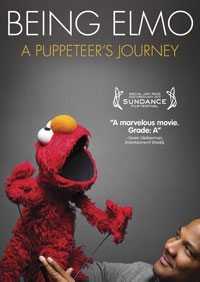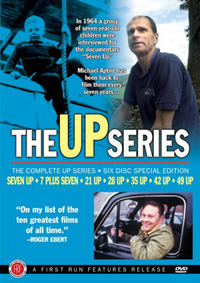Being Elmo: A Puppeteer’s Journey
 THE CLASH
THE CLASH
Kevin Clash grew up in a sizable family of humble means. He began watching Sesame Street as a young boy, which led to watching The Muppet Show. His ravenous interest in creating and performing his own puppet characters grew. He started performing for children at his mother’s day care center, which led him down a path that would ultimately blossom into a promising career as a puppeteer. But not just any puppeteer. He would ultimately become one of children’s most beloved icons, a little red fury monster named… Elmo! Not too shabby for a shy boy from the suburbs of Baltimore.
The Fog of War

We hear Robert S. McNamara's voice before we actually see him – then he tells the director, "I don't want to go back and introduce the sentence because I know exactly what I want to say." McNamara is candid, opinionated, and passionate – qualities appropriate and endearing from America's former Secretary of Defense, under President Kennedy and President Johnson.
Here Errol Morris offers us a former leader of America's military force's inside knowledge in our nation's war-driven period from the Cold War to the Vietnam War. Some of the information McNamara reveals is astounding. What moved me was that, in the film, he is emotional and intimate – I felt privileged to be able to hear what this historical figure had to say. He explained the results of our actions in several aspects – from the statistical numbers our position in war has had on our daily lives, the impact of our technological weapons, and his own position on being our Secretary of Defense.
Continue ReadingMoog

Who knew Bob Moog had so much energy and excitement? I mean, I guess you would have to if you were the inventor of the one musical instrument to change the face of music for at least the last forty years! This is an inspiring portrait of the inventor of the Synthesizer--the Moog Synthesizer. The one and only, used by everyone from Jan Hammer to Devo and in many soundtracks including Stanley Kubrick's The Shining. Musicians spanning all genres have included the Moog Synthesizer in their repertoire. From Hip Hop to Experimental and Pop to Avant Garde. Almost everyone can agree that Robert Moog invented a masterpiece of equipment when he started playing with sound waves and harnessing electrical currents.
Moog states that he "fell right into it." He was an engineer who stumbled upon an idea that just blossomed. His bright personality, which is clear in the many interviews included in the film, and his love and passion for his creation helped to bring the instrument to prominence. He had a gift for inspiring people. This documentary proves that fact. With multiple interviews by people who knew him or were inspired by him we get a glimpse of the impact this one man, and his invention, had on the way we hear music today. We also get rarely seen footage of the man himself showing off his creations as well as the studios they are built in. We see him interacting with the musicians who adore and love him for what he has given them. And we see his humbleness and reciprocal love for the musicians themselves.
Continue ReadingYellow Brick Road

When you're walking past all the asphalt and gleaming metal of the city, you forget how to feel sometimes. That never seemed to happen when you were a child. You were in tune with everything—you felt everything and wanted so much to please. Then you grew older and you noticed that the world had plans for you. If you felt something very powerful, or loved something fiercely, you learned to keep it to yourself. It hurts to contain it sometimes, but you do it all the same. For the group of disabled actors in the A.N.C.H.O.R drama program of Long Island, that is simply not a reality. What the human race has fallen out of touch with, these children and adults practice with bliss.
Every year, drama director Sandy Braun gathers the same eager actors in the program and puts on a wonderful performance with little support from outside sources. Most of the members are young adults and the disabilities range from Down syndrome as the majority, and others spanning from paralysis to several mild forms. This documentary follows the trials and tribulations of the group as it tries to pull off the best Wizard of Oz they can muster. They all gather in an auditorium and the drama director announces who received what part. I literally burst into tears when I saw their glee and satisfaction, particularly from one girl who becomes overwhelmed. The Wizard is played by a man named Josh, who is modest and pleased with the news. Dorothy, the Scarecrow, and the Wicked Witch are played by Trisha, Danny, and Elizabeth. The star of the program, John Stare, has the role of the Cowardly Lion. Another favorite in the group is David, who plays the Tin Man.
Continue ReadingI’m Still Here

It’s hard to categorize the film I’m Still Here. Simply put, it plays as a documentary that illustrates a man in free fall. To suggest, however, that it is a true documentation of such only serves to perpetuate the myth (as well as the egos of its makers) behind the film itself. On the other hand, the suggestion of truth is what makes this film possible within the ether of today’s stagnant and highly unentertaining… well… entertainment. It’s pointless to over-analyze Casey Affleck’s directorial debut, as in doing so would only allow yourself to be hoodwinked by two very talented satirists who have set out to do just that: orchestrate an elaborate hoax intended to turn the mirror on the Hollywood machine and also shed light on America’s obsession with celebrity.
I’m Still Here is the fictional account of Joaquin Phoenix’s decent into madness. The film opens with Phoenix pacing around the front yard of his Hollywood Hills home while the city glimmers below. The stage is set as Phoenix declares, "I’m living in a self-imposed prison." What we see here within the first three or four minutes of the film is someone who is lost and is trying desperately to find his true identity. That identity comes in the form of J.P., the alter ego and hip-hop artist formerly known as the actor, Joaquin Phoenix.
Continue ReadingThe Thin Blue Line

Two men are in prison for the rest of their lives. One is Randall Dale Adams, an average man who appears rational, patient, and has had no distinct trouble with the law. The other is David Ray Harris, a young and destructive delinquent on death row after many years of trouble with the law. On November 28, 1976 their paths crossed in an act of gratitude and friendlessness when Adam had car trouble and the then 16-year-old Harris offered him a ride. By morning, a police officer would be shot dead and the trial to decipher which of them is guilty is enough to plot an entire trilogy of thrillers.
Documentaries are a strange breed of cinema, outlined by rules and guidelines set forth in order to produce "cinéma-vérité." This quest to give the audience "truth" leaves absolutely no room for bias, or theatrics for that matter. That is of course until Errol Morris came through with The Thin Blue Line, a documentary that successfully argues the innocence of a man and eventually leads to his release. After all, once you put a camera up to any situation, you are in some ways distorting truth. Morris simply adds reenactments and colorful visuals to the frame in order to give an appropriate feel to a film documenting a crime and the lousy justice department that attempts to solve it.
Continue ReadingDeliver Us From Evil

You don’t have to have or understand religion in order to understand spirituality. Most everyone has a source of reason or a spirit of life that feeds our quest for a healthy existence and is the foundation of our morals. Whether it comes from deities or an inner muse, every person who decided to remain a part of this world has their own way of defining purpose. Deliver Us From Evil deals with the corruption of such spirituality in the Catholic Church.
This is a brave and gut-wrenching documentary about the corruption of faith among the youth and families of several parishes in California. It touches on a sickening truth - that some years ago, the Catholic Church re-formed its guidelines which allowed a priest to get married and have children, as the resulting male sons would inherit his assets instead of the church. Now removed from the option of finding romantic adult peers, an alarming number of Catholic hierarchy, many of whom were sexually abused in childhood, now see children as their sexual peers.
Continue ReadingThe Cruise

The hook of The Cruise is that most New York tour guides are jaded wage slaves repeating the same statistics and soulless anecdotes to dozens of tourists every day, but “Speed” views his “loops” as an opportunity to communicate the transcendental joy of being alive in New York, a city he anthropomorphizes in different forms, giving the film a second character, and in a sense a plot. Miller operated the camera himself and he manages to shoot New York with a sensual, humble idiosyncrasy worthy of “Speed” himself. The last shot of the film feels a touch contrived, but the presence of the World Trade Center’s erstwhile towers will haunt any viewer.
It’s difficult, and perhaps impossible to impart the appeal of the documentary The Cruise without quoting its protagonist Timothy “Speed” Levitch at some length; this is in itself a disservice to any potential viewer of The Cruise because the poetry of Speed’s erudition is best seen “live”, being delivered spontaneously by the man himself, rather than being read. Speed’s hyper-articulateness must be heard to be appreciated. To listen to Speed’s quotidian orations is to discover a human being who can extemporaneously compose sentences of Jamesian complexity. So fear not, gentle reader. His words are yours to discover.
Continue ReadingCitizen King

The story of the Civil Rights Movement was almost made for television. It was done in front of TV cameras and acted out for the the television news audience. Much of the time the goal was shining a light on the abuse black Americans were suffering at the hands of the racist Southern political structure. Unfortunately, unlike say, the Vietnam War, the Civil Rights Movement does not have a very long list of important films about it. There have been solidly crafted films like Alan Parker’s Mississippi Burning, but like most of them it’s actually about white people (the FBI v.s. the KKK. Now remind me again, which side are we supposed to root for?). Ironically, the best film inspired by the American Civil Rights Movement is a foreign one, Bloody Sunday, the Paul Greengrass docudrama about the massacre of Irish protesters by British troops.
The epic PBS documentary series, Eyes On The Prize, has become the bible of everything you could ever want to know about the Civil Rights Movement, but unfortunately due to licensing and rights issues, it has gone out of print on VHS and is only now available for educators. Luckily two of its producers, Orlando Bagwell and Noland Walker, also wrote and directed Citizen King for the PBS series, American Experience. And at under two hours it manages to tell a lot of the Martin Luther King, Jr. story with the perfect mix of archive footage and talking heads.
Continue ReadingThe Up Series
 Imagine what it would be like to have a visual journal of your life from childhood to middle-age. Would you find the footage painful or nostalgic? Now imagine that this footage is aired on a yearly program in your nation and later available for purchase across the world. Many of us cannot begin to fathom what that would be like, even with the rise in reality television, but for a small group of Brits, it's been a reality for decades.
Imagine what it would be like to have a visual journal of your life from childhood to middle-age. Would you find the footage painful or nostalgic? Now imagine that this footage is aired on a yearly program in your nation and later available for purchase across the world. Many of us cannot begin to fathom what that would be like, even with the rise in reality television, but for a small group of Brits, it's been a reality for decades.
In 1964, directors Paul Almond and Michael Apted started a program for BBC called Seven Up!. The project was part of the World in Action series. Apted, along with Gordan McDougall, chose 14 children from different socioeconomic backgrounds, many offering extremes within the range. The motto of the project is “give me the child until he is seven, and I will give you the man,” based on a quotation from Ignatius Loyola. Given the harshness of the U.K. class system, those involved predicted that the children featured would more or less follow paths that could be expected of them, based on their background. The children range from illegitimate orphans to the extremely pampered, and in order to expose them to children from different class groups, they threw them together in a field trip and studied their behavior through contrast. Following this trip were in-depth interviews with each child and their close peers. This longitudinal study is then repeated every 7 years. The programs are as follows: Seven Up!, 7 Plus Seven, 21 Up, 28 Up, 35 Up, 42 Up, 49 Up, and a rumored 56 Up is to be aired in 2012.





